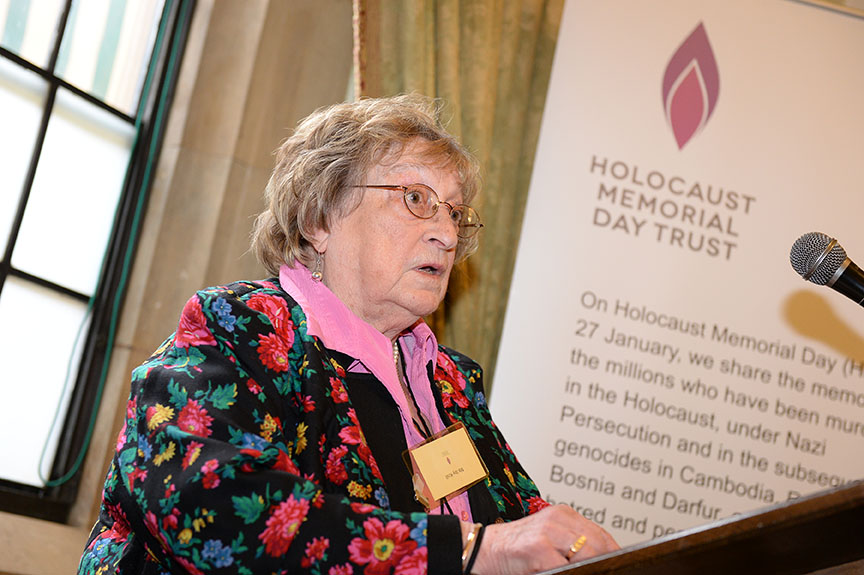HMDT Blog: Don’t stand by: by Iby Knill, survivor of the Holocaust
Iby Knill was transported to Auschwitz from Hungary in 1944. As part of our 2011 Hidden Histories project Iby told us about her father's watch chain. Her father threw the chain to Iby's brother as he was being marched away to be deported to his death.

When I was about eight years old, there was a fashion for ‘autograph books’. I presented the book to my teacher who wrote in it (roughly translated from German): ‘What you do, do well: it is better to do nothing than doing things badly’.
Then my English teacher wrote: ‘If at first you don’t succeed, try, try again!’
I found it really difficult to get these two statements to agree:
The first one appeared to me to leave things I could not do to those who could, but the second was quite different. I wondered was this the difference between the German and English attitude to life?
It was not until much later that I realised that I had misconstrued the German proverb. What it really meant was: when it comes to taking action, do what is right; it is better not to do anything rather than to do evil.
And for a long time what was the governing principle in my life: DO NO EVIL.
Yet – I started to wonder: standing by and doing nothing when somebody else does something evil? Is this not tantamount with doing evil, by not actively doing good? Where are the boundaries?
I never counted the fact that I was involved in the underground movement helping downed Allied aircrew to escape as an action coming under the heading of doing right; it was just something I got involved in, unintentionally, but with dire consequences.
After my cousin was called up to the military I was hidden by a solicitor and his wife. He was involved in the underground movement, which helped Allied aircrew, who had bailed out, to make their way from German-occupied countries through Greece to Crete, where there was still a British presence. It was my job to pick them up – there were usually two of them – and pass them on to others who would help them on their way. Unfortunately, somehow the movement was betrayed, all 428 of us were arrested and we were interrogated – quite forcibly. Being an illegal immigrant with false papers I was particularly vulnerable, but I only knew members of my cell. I was sent to the women’s prison in Budapest, where the interrogation continued. The Hungarian government decided, eventually, not to prosecute us; I was released from prison, but immediately re-arrested as an illegal immigrant and spent nearly two years in detention centres and refugee camps. Shortly after my release in March 1944 – on parole – the Nazis occupied Hungary and I finished up in a brickyard and then – on 17 June 1944 in Auschwitz-Birkenau.
I left Auschwitz after volunteering to do slave labour as a nurse.
It was when I was in charge of the hospital at the Lippstadt slave labour camp that I actively and purposefully tried to take the ‘right’ action.
There were 780 women in the camp. According to German strict rules there could never be more than 0.5% ill and in hospital. Epidemics of contagious diseases and work accidents were no excuse for exceeding the magic number of 38 patients.
But there were occasions when we had fewer patients. People worked 12 hour shift, days and night and some people got more exhausted and would have been liable to more work accidents. Wherever possible I tried to give a few days’ rest to such people – it was an open secret how to manipulate the thermometer and give a bogus high reading. And we also managed to hide the three woman who had given birth there and who were breastfeeding their babies.
But it was not always possible to take in all who needed or demanded it.
And one of those told the commandant – or one of the guards – what I was doing.
The next day I was accused of ‘sabotaging the war effort’, no longer in charge of the hospital and put on the 12 hour night shift in the factory on the heaviest machinery.
Actually this gave me more opportunity to sabotage the war effort. Tolerance levels on machine gun bullets were low and I somewhat managed to exceed these nearly continually: my excuse being that I had no experience in this sort of work – so what could they expect of me?
Fortunately, for all of us, supplies of iron to the factory stopped and we were put on a march to Bergen-Belsen. We never arrived there – we were liberated by Allied troops on 1 April 1945.
Thinking about what my German teacher wrote and talking about it to my children has actually thrown up many problems: Obviously, if it only concerns you – you can stand up, speak up and act accordingly – but what do you do, when you are a mother and your children’s life and safety depend on you? Would you sacrifice them? Do you have the right to do so?
I do not have the answer to this: In the end, it is up to each and every one of us to decide – and to live with the consequences of our actions – or non-actions.
Each one of us can make a difference – non-action is not an option!
The HMDT blog highlights topics relevant to our work in Holocaust and genocide education and commemoration. We hear from a variety of guest contributors who provide a range of personal perspectives on issues relevant to them, including those who have experienced state-sponsored persecution and genocide. The views expressed are those of the author and do not necessarily represent the views of HMDT.